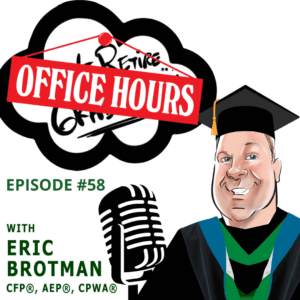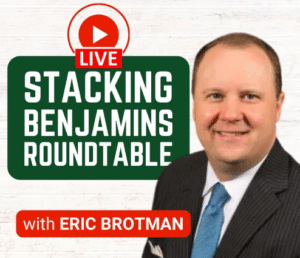In today’s Office Hours, Eric answers Brianna’s question: “What is the real reason that financial advisors have asset minimums?”
Take a look under the hood to understand how financial advisors generate revenue, what asset minimums are for, and how BFG is doing things differently with Financial Planning for All.
Have a question? Post it in the comments, tweet it to us at @BrotmanPlanning, or post it on our Facebook and it may be used in a future episode of Office Hours!
[00:00:00] Eric Brotman: This is Eric Brotman, the host of Don’t Retire… Graduate!: The podcast that teaches you how to advance into retirement rather than retreating. Welcome to office hours where we answer listeners questions about personal finance, retirement readiness, and more. We received a question from Brianna who asked, “what is the real reason financial advisors have asset minimums?” And Brianna, I love this question because so many of our questions are about personal finance, but this is really about our industry and sort of looking under the hood and saying why do financial advisors do things a certain way and, and what’s the, the business reason or the, or, or other financial reasons to do it?
So let me answer this as simply as possible in most financial advisory relationships, revenue is generated by financial advisors in multiple ways. Sometimes they’re commissionable engagements or transactional engagements. Sometimes they are fee for service, whether it’s a flat fee or retainer fee or an hourly fee. And sometimes it’s based on a fee as a percentage of assets that are being managed. So when you ask about asset minimums, that’s typically what you mean. What is the percentage being charged on the assets and how does that create ongoing revenue for the firm to then take care of all the clients being served. In almost every financial advisory 1.0 seminar, workshop, course or whatever we could do, there’s this idea that what you need is fewer clients and larger clients. And that is the way that our industry has been built, it is also specifically why we at BFG have chosen not to do it that way. We’re traveling in the opposite direction of the herd, Brianna. And the reason we’re doing that is because we realize that there are ways to create sustainable financial advisory practices without having asset minimums.
So we’re very proud of the fact that we’ve built something called Financial Planning for All. And that that is a program that is available to a much broader audience. Now that’s not to suggest that financial advisors who have asset minimums are bad people or that you shouldn’t work with them. I mean, in some cases it’s important for you as a client to be in the wheelhouse of the firm you’re working with.
So in other words, you don’t wanna be somebody’s biggest client, but you also don’t want to be their smallest client. You wanna be in their sweet spot. And that’s true in almost any industry and ours is no exception, but when firms say we’re, we’re not gonna talk to folks under a certain asset level, I think they’re making a calculated decision.
And I think for many it’s a miscalculation and a mistake. The reason I say that is that for financial advisors to be truly valuable to families, I believe that you need to do multi-generational planning. And multi-generational planning means you’re not just working with the generation of a family that maybe has a higher net worth.
You’re also working with their parents who might be spending money down or having some struggles or having long-term care issues. It means you’re working with their kids who might be educating their grandchildren and you have three or four generations of a family and they’re all in different places financially.
And so in a perfect world, I think a financial advisory relationship should be with the whole family and should be able to not only look at accumulation and look at de cumulation and preservation of assets. It should also be able to look at tax strategies between generations and philanthropy and all the things that come into financial decision making.
You know, when you talk about leaving money and you wanna leave money behind say to your three children, and maybe that’s a priority for you and maybe it’s not, but if it is, and you have three children and you wanna leave them money, do you leave them all the same amount of money? What if one of them is an investment banker making obscene money and one of ’em is a preschool teacher. What if one of ’em is in a very high tax bracket? One of ’em is in a very low tax bracket. What if one of them is just a terrific kid and has grown up to take care of you and is doing a great job. And the other one you haven’t spoken to in 10 years. I mean, I’m oversimplifying, but the reality is that financial advisors who have minimums and will only work with couples or families over a certain level are missing the opportunity, I believe to do some of the best and most important work in our industry.
And when we look at our typical client, because you should ask if you’re, if you’re going to a financial advisor, you should say, who are your typical clients? And, you know, we, we had a guest on our show recently who said if, if a financial advisor answers that question and it’s, oh, our clients look just like you run because they haven’t actually answered the question.
They’re just blowing smoke. But if they say, like, we would say our typical client shows up on our doorsteps, they’re between 45 and 65 years old. They’ve got parents getting older. They’re worried about, they’ve got kids to educate, they’re working 50 and 60 hours a week. They’re busy people and they just want some help making big decisions.
And they want to essentially outsource some of the financial decisions in their lives. The short answer is that’s what we do. And we can help those families. And I don’t care if they have $10 million or $2 million or $200,000. At the end of the day, we can create an engagement that does not require asset minimums.
It doesn’t even require them to have assets. And so a financial advisor has to make these decisions. And what we decided is we’re gonna have a flat fee engagement. So there are no surprises. And that flat, fee’s going to be an annual retainer for folks who want ongoing service, whether they have assets with us or not.
And then the asset management, we do certainly work with high net worth folks, but not. And actually the variety is part of what makes this job fun. So Brianna, the real reason financial advisors have asset minimums is because they don’t want to grow the infrastructure. They don’t know how to make a profit from smaller relationships.
And they’re trying to cherry pick and only go after the, the, the richest of the rich. And to me, that’s, it’s a fine business model and it works for some, but it wouldn’t give me any kind of any kind of joy or satisfaction. We love the fact that we can work with families across the spectrum. So thank you so much for your question.
If you’d like to send us a question, which we might answer in a future episode of office hours, post it on our Facebook page, or tweet us at @brotmanplanning. If you like, what you hear, please subscribe to our podcast and leave a rating on Spotify or wherever you listen to your favorite shows. Please also check out our books, workbooks and online financial literacy resources at brotmanmedia.com.
Thanks for coming to office hours. Be sure to tune in for new content every Thursday for now, this is your host, Eric Brotman reminding you don’t retire. Graduate.
[00:06:34] Narrator: Securities offered through Kestra investment services, LLC Kestra IS. member FINRA SIPC. investment advisory services offered through Kestra advisory services, LLC.
Kestra AS. an affiliate of Kestra IS. Kestra is or Kestra as are not affiliated with Brotman financial or any other entity discussed.







